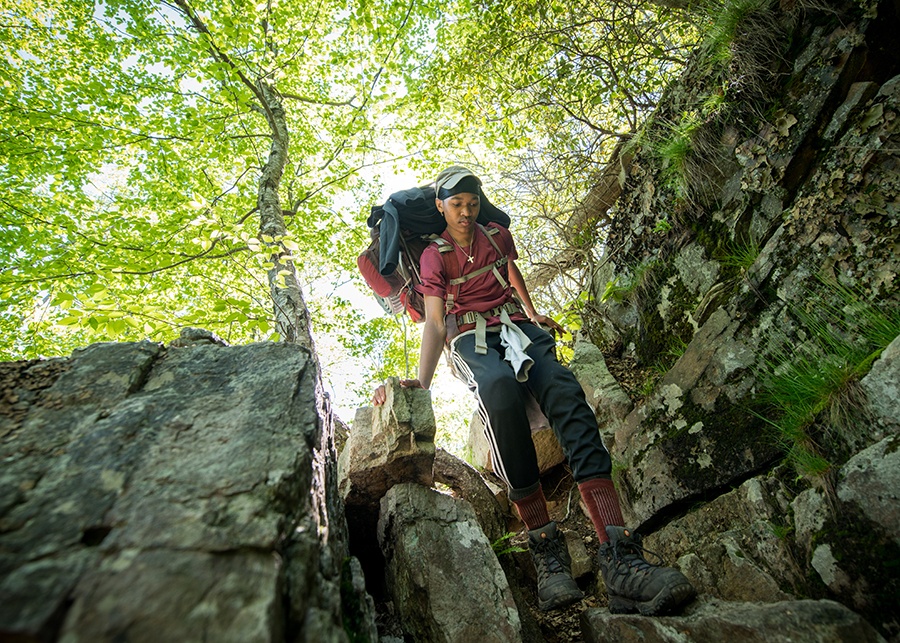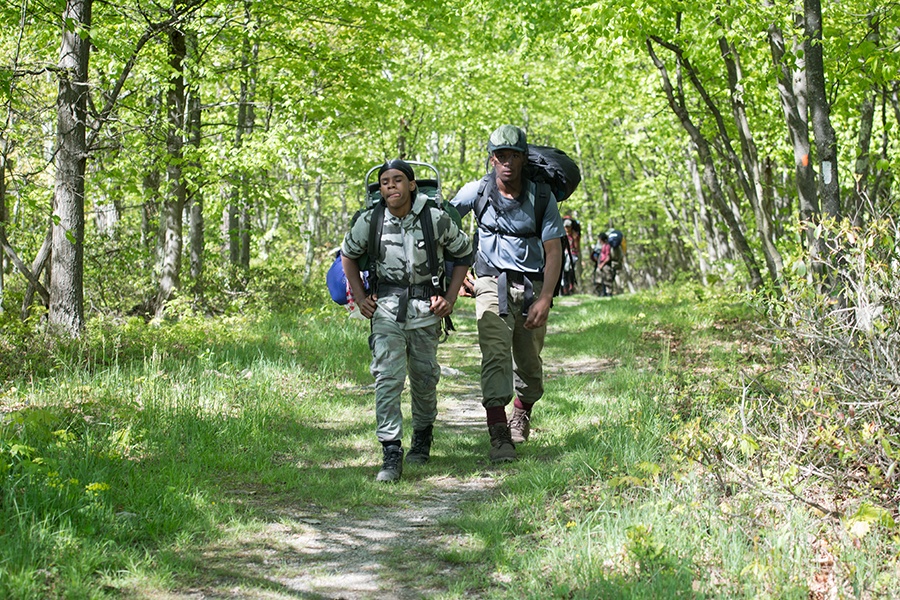Learn More
Stay Together
Learning Lessons
High-School Students Develop Backpacking and Leadership Skills on the A.T.
By Jessica Porter
 After spring exams, most high-school freshmen are anxious to begin their summer vacations. However, that’s not the case for the freshmen at St. Benedict’s Preparatory School, an all-boys, inner-city college preparatory school in Newark, N.J.
After spring exams, most high-school freshmen are anxious to begin their summer vacations. However, that’s not the case for the freshmen at St. Benedict’s Preparatory School, an all-boys, inner-city college preparatory school in Newark, N.J.
At the end of their freshman year, all students at St. Benedict’s must participate in a backpacking project that culminates in a five-day trip on the Appalachian Trail starting at High Point, N.J., and ending at Delaware Water Gap, Pa.
The project encourages students to learn and apply leadership skills while successfully navigating the nearly 50-mile route. It’s an impressive endeavor for the students — most of whom are more accustomed to inner-city Newark than the woods. For many, it’s their first experience backpacking.
“Years ago, we went out with the kids to prepare for the Appalachian Trail trip,” says Dean Glenn Cassidy. “We had about five kids with us and were playing cards in a cabin at night. One kid gets up and runs over to lock the door, asking ‘aren’t there crazy people out here?’ I said ‘Weren’t seven people shot outside your building last month?’ That was normal for him, but it was scary for him to be in the woods.”
Taking on the Trail
Knowing students are not accustomed to spending time in nature, St. Benedict’s staff spends a lot of time ensuring the students are mentally and physically prepared. For three weeks, students learn basic backpacking skills — cooking, camping, navigation and first aid. Before heading out on the A.T., students go on one-day and three-day hikes to practice their skills.
But backpacking is just one part of the project; it’s equally important to learn leadership and team building skills. The students divide themselves into teams of eight people and each team elects a captain. All team members become experts in a specific task, so no one student has every necessary skill. One student is elected captain, two learn first aid, two learn backcountry cooking, two are navigators and one is the camping specialist tasked with finding campsites, caring for gear and helping to set up tents. Every member of the team is a valuable component to successfully completing the trip.
“We call this horizontal dependence and vertical independence. The idea is that we should be able to put any team in the woods, hike for five days and they should not need anyone other than themselves,” Cassidy says. “They have all the skills and have learned how to work together. Students are independent of the people above them but dependent on their teammates.”
Though staff members and older students are with the teams to ensure safety, they make sure the team is solving problems and leading the hike. If the team goes off trail or makes mistakes, the supervisors simply follow, requiring the team to figure out solutions.
After three weeks of training, the teams are ready for the five-day trek. Because there are so many freshmen (last year nearly 150 students participated in the project), the teams depart over three days to ensure minimal overcrowding on the trail.
Though some students have camped before via Boy Scouts or family outings, most have never spent the night in the woods prior to preparing for the backpacking trip. Some are receptive to the trip; others are not.
“Some kids are afraid of their own shadow and extremely afraid of bugs and spiders,” Cassidy says. “It’s funny when they are tough kids in school but scared bugs on the Trail.”
After the trip, some students choose to participate again as upperclassmen, helping to guide the new freshmen. Others are happy to never return to the woods again.
“Some get to the point where they don’t care about the bugs anymore, they just want to get home. Some go home and burn their boots,” Cassidy says.
No matter whether they enjoy the experience or not, the five-day hike is memorable for all.
“It’s something the kids hold dear,” Cassidy says. “They may hate every step, but former students come back in 30 years telling stories from their time on the Trail.”
“It’s something the kids hold dear,” Cassidy says. “They may hate every step, but former students come back in 30 years telling stories from their time on the Trail.”
Half a Century of Experience
St. Benedict’s Preparatory School began the backpacking project in 1974, a year after reopening the school with the goal of presenting a unique education model that encourages students to try new things through experiential learning.
 Teachers presented their areas of expertise that could become hands-on programs, including architecture, martial arts and drama, and selected students to participate. A number of students known to be troublemakers were not selected to participate in any program. The headmaster and a teacher decided to take those students hiking — despite having no hiking experience themselves.
Teachers presented their areas of expertise that could become hands-on programs, including architecture, martial arts and drama, and selected students to participate. A number of students known to be troublemakers were not selected to participate in any program. The headmaster and a teacher decided to take those students hiking — despite having no hiking experience themselves.
The headmaster and teacher spent a few weeks learning the basics of backpacking and then began teaching the students. Soon after, a teacher came on board with a strong background in hiking and camping, adding structure to the program that’s helped it continue over the years.
Though small tweaks have been made to the project over the years to accommodate the increasing number of students and their diversifying needs, it’s largely the same as it was in 1974. In the past nearly 50 years, 4,000 St. Benedict’s Preparatory School students have hiked the Trail, learning the lessons only a few days of backpacking with teammates can teach.
Jessica Porter is a freelance writer and editor who thru-hiked the A.T. in 2014. For more information, visit www.JessicaLynnePorter.com. Photography: ©2018 Horizonline Pictures
